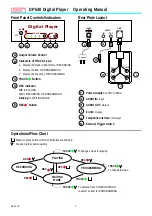
47
Motor Control
11.1.2.6 Adaptive Regulation Frequency
The decoder operates ex works with a mutable (adaptive) regula-
tion frequency to drive the motor as precisely as possible. How-
ever, as a result some motors might show a nasty buzzing noise.
For such motors you are able to set the regulation frequency on a
constant value. Set bit 4 to “1” in CV 124.
11.1.3. Automatic calibration of the motor
LokPilot V4.0 decoders offer a feature for automatic calibration
of the motor. I most cases this procedure leads to excellent load
compensation characteristics. However, due to the infinite number
of possible combinations of motors and gear boxes a good result
cannot be guaranteed in all cases. But it is certainly worth a try.
Proceed as follows:
Set the vehicle onto a piece of straight and preferably level track.
•
This track must be at least as long as to allow the locomotive to
run at full speed for about two seconds. This movement takes
place automatically during calibration. Provide buffer stops or
something similar to prevent the locomotive from running off the
track!
Call up the locomotive on your throttle and make sure that F1 is
•
switched off and the throttle is set to speed step 0. Set the direc-
tion of travel as desired.
Write the value 0 into CV 54 (either on the programming track
•
or with POM).
Now press the “F1” button. The locomotive will start running at
•
full speed automatically. During about 1.5 seconds you will not be
able to control this locomotive!
The locomotive will automatically stop and the identified load
•
compensation parameters will be saved in the CVs 51, 52, 53,
54 and 55.
If you wish you can now further optimise the load control param-
•
eters starting from the calibrated settings.
11.2. Turning off Load Compensation
LokPilot V4.0
LokPilot V4.0 DCC LokPilot V4.0 M4
LokPilot micro V4.0
LokPilot micro V4.0 DCC
LokPilot XL V4.0
You can also switch off load compensation by writing the value 0
in CV 56 („Control Influence“).
With load control turned off, the starting voltage in CV 2 should
be increased until the locomotive starts moving at speed step 1
or 2.
11.3. Adapting Load Control Frequency
LokPilot V4.0
LokPilot V4.0 DCC LokPilot V4.0 M4
LokPilot micro V4.0
LokPilot micro V4.0 DCC
LokPilot XL V4.0
In the LokPilot decoders load control works normally with 40 kHz.
Sometimes it can be useful to reduce this frequency by half:
For motors with little power due to high inductivity.
•
If suppressors (such as capacitors, chokes, etc.) disturb load control
•
but cannot be removed (e.g. some older Gützold® locos).
Delete bit 1 in CV 49 in order to set the PWM frequency from 40
KHz to about 20 kHz.
11.4. Dynamic Drive Control: Up and Down the Hill
LokPilot V4.0
LokPilot V4.0 DCC LokPilot V4.0 M4
LokPilot micro V4.0
LokPilot micro V4.0 DCC
LokPilot XL V4.0
Dynamic Drive Control of your LokPilot decoder enables you to
adapt load control, as you may desire. Full control over the entire
Summary of Contents for LokPilot Fx V4.0
Page 74: ...74 Notes ...















































